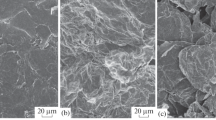Abstract
This work investigates the feasibility of developing a lower cost dimensionally stable anode based on a polymer substrate by examining possible methods of applying coatings, such as MnO2, to catalyse the oxygen evolution reaction. The conductive polymer is based on a blend of polypropylene and a rubber, to provide the mechanical strength and acid resistance of the electrode, with graphite fibre and carbon black dispersed through the composite to ensure a reasonable conductivity. Of the different compositions analysed, the best incorporated Degussa XE-2 carbon black. This material not only displays an overpotential at its bare surface which was comparable to the lead electrode, but also it provides excellent contact with the catalyst coatings. Two methods of applying a catalytic coating, thermal decomposition and pressed oxide coating, are evaluated. Coatings prepared by thermal decomposition displays an overpotential greater than the standard lead electrode, although the poor performance of the catalysts is found to be due to poor contact with the conductive sites of the substrate and to incomplete thermal decomposition of the metal chlorides to the oxide. The pressed oxide coating method is the technique developed during this work to take advantage of the properties of the polymer composites. Polymer substrates are heated until soft and the MnO2 catalyst (in its active form) is pushed into the surface. Electrodes coated in this manner with MnO2 all display excellent overpotentials which, on average, are 0.2 V less than the lead electrodes. Extension of this technique to the coating of polymeric substrates with other catalytic oxides shows great potential.
Similar content being viewed by others
References
C. H. Comninellis and G. P. Vercesi, J. Appl. Electrochem. 21 (1991) 335–45.
V. DeNora, US Patent 4 302 321 (1981).
H. B. Beer, US Patent 3 632 498 (1972).
V. Haddadi-Asl, M. Kazacos and M. Skyllas-Kazacos, J. Appl. Polymer Sci. 57 (1995) 1455.
S. Zhong, M. Kazacos, M. Skyllas-Kazacos and V. Haddadi-Asl, International Patent WO 94/06164 (1994).
V. Haddadi-Asl, M. Kazacos and M. Skyllas-Kazacos, Proceedings of the 9th Australian Electrochem. Conference, Wollongong, NSW, Australia (1995) p. 64.
M. Skyllas-Kazacos, D. Kasherman, D. R. Hong and M. Kazacos, Proceedings of the Solar '89 Conference Australian and New Zealand Solar Energy Society, Brisbane, Australia, 2 (1989).
Gould Inc., ‘Development of Zinc Bromine Batteries for Stationary Energy Storage’, EPRI EM-2497, July (1982).
V. Haddadi-Asl, M. Kazacos and M. Skyllas-Kazacos, J. Appl. Electrochem. 25 (1995) 29–33.
G. L. Cahen, J. Electrochem. Soc. 135 (1988) 368–72.
Author information
Authors and Affiliations
Rights and permissions
About this article
Cite this article
Brungs, A., Haddadi-Asl, V. & Skyllas-Kazacos, M. Preparation and evaluation of electrocatalytic oxide coatings on conductive carbon-polymer composite substrates for use as dimensionally stable anodes. J Appl Electrochem 26, 1117–1123 (1996). https://doi.org/10.1007/BF00243736
Received:
Revised:
Issue Date:
DOI: https://doi.org/10.1007/BF00243736




